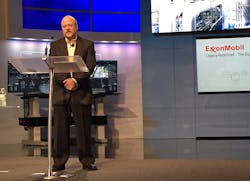As an oil and gas supermajor, ExxonMobil has a large installed base of legacy distributed control systems (DCSs) running its operations. When David Patin asked an audience of Honeywell customers how many of them were—like ExxonMobil—running the TDC 3000 in their facilities, a significant number of them raised their hands.
The TDC 3000 was a state-of-the-art DCS in 1985. Despite the 30+ years of equipment service, nobody wants to hear the words “rip and replace.” Replacing any DCS is very expensive, risky and disruptive to operations. ExxonMobil has also developed a significant amount of intellectual property (IP) around the system, including supervisory control, displays and third-party interfaces.
But several key hardware components are approaching end of life around 2025. The Motorola processor released in 1990 will no longer be produced, and a key network chip was taken out of production in the early 2000s.
The fact is that ExxonMobil was facing a massive rip and replace. “So we did what we do best,” said Patin, a distinguished engineering associate in the Automation Division—Control Systems Section at ExxonMobil Research and Engineering. “We issued a challenge to Honeywell to prevent this from happening.”
Honeywell and ExxonMobil put together a task team to study the problem. Less than seven years later—two years ahead of schedule—Honeywell delivered a system that fit the bill. ExxonMobil, for one, couldn’t be happier with the results. “I think I’d probably give Honeywell an A on this one,” Patin told the audience at the Honeywell Users Group (HUG) Americas symposium this past week in San Antonio, Texas.
What began as a discussion about how to stretch the life of the TDC 3000 to the year 2040 turned into a practical way to make it last forever instead, said Jason Urso, chief technology officer for Honeywell Process Solutions. By virtualizing legacy hardware nodes as software, the automation supplier eliminated rip and replace altogether. “This eliminated the leading cause of end of life of a system, which is component obsolescence,” Urso said. “We can run what was a 40-year-old platform on any hardware that is current in the day.”
With the release of Experion LCN (ELCN) R501.1 in February, Honeywell addressed several requests put forth by ExxonMobil. In addition to avoiding a very costly TDC 3000 system replacement and preserving its IP investment, the oil producer asked for on-process migration, unification of TDC with Experion, and new capabilities to capture more value from the current TDC 3000. And oh, by the way, make sure it’s still reliable and secure. “TDC has been very reliable,” Patin said. “If we’re going to mess with it, we need to make sure we don’t mess with the reliability.”
TDC was already somewhat unified with Experion, Honeywell’s current state-of-the-art DCS, but ExxonMobil wanted it to be more so, Patin said. “The main reason was shifting to a younger workforce. It needs to be able to withstand the test of time, but also be used by a younger generation,” he said. “There’s some kid sitting in a third-grade classroom right now that’s going to be a TDC engineer; they just don’t know it. So we’d better get this right.”
The end result of the work is a system that is emulated as software. “What used to be a board is now a piece of software,” Patin said. “It’s completely binary-compatible with the old system.”
The current TDC software runs unmodified, which greatly reduces technical risk, Patin noted. ExxonMobil’s IP—such as application code, displays, checkpoints and databases—are preserved. ELCN nodes are implemented in Windows (physical or virtual), Universal Embedded Appliance or a virtual appliance. “We’re able to implement software on pretty much any hardware using these three different form factors,” Patin added.
Local control networks (LCNs) and universal control networks (UCNs) are virtualized on Fault Tolerant Ethernet (FTE), with LCN and UCN messages encapsulated in the Internet Protocol. An Experion LCN Bridge—a universal embedded appliance that enables the coexistence of classic LCN- and ELCN-based nodes—supports on-process migration, one node at a time, over an extended period.
Full ELCN virtualization is possible now, with Patin marveling that a DCS will be able to fit inside a pizza box within five years. Virtualization also enables lower-cost, smaller-footprint operator training simulators. And support from Honeywell’s Open Virtual Engineering Platform enables cloud-based engineering for the ELCN/EUCN. “This is something we just couldn’t do with TDC,” Patin said. “Now we’re going to be able to host the LCN in a cloud-based system for engineering development.”
In the end, what Patin calls “brilliant engineering” not only met the challenge—future component issues eliminated, IP preserved and on-process migration supported—but exceeded ExxonMobil’s expectations. “ELCN technology essentially resets the odometer on your TDC 3000 investment,” he said. “It’s an excellent example of Honeywell’s commitment to continuous evolution.”
About the Author
Aaron Hand
Editor-in-Chief, ProFood World

Leaders relevant to this article:
